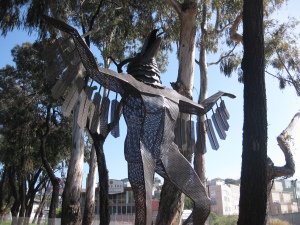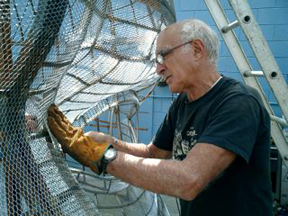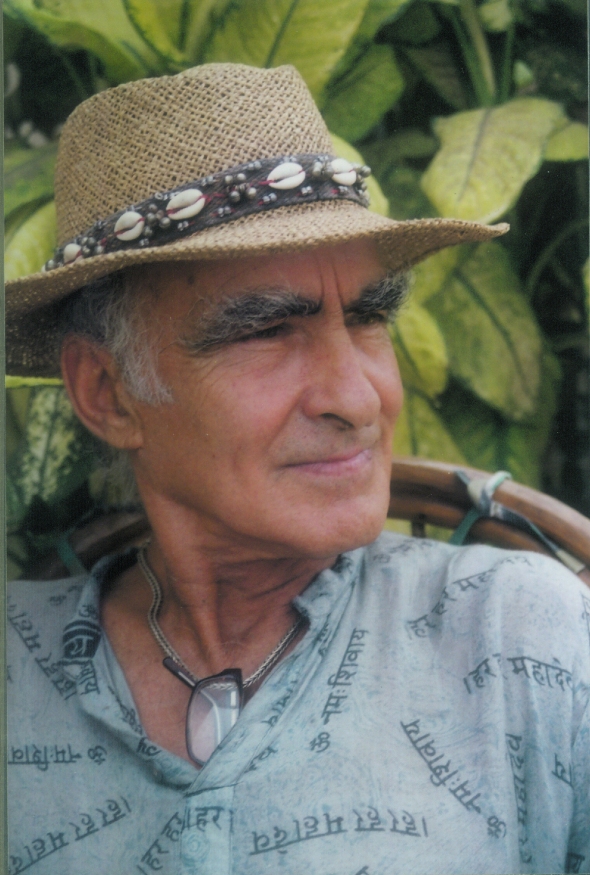Invocation – Pepe Ozan
You are well known for your amazing artworks and continuing involvement for the last fifteen years at Burning Man Festival. How has the whole experience affected you as an artist and as an individual?
It changed my life. It was a big jump in my career. It jumped from sculpture to the degree of architecture, it was a great opportunity to take my capacity to the extreme. Burning Man is an art event of radical expression, participation and community. It’s a great chance for sculptors to express themselves to the biggest and maximum stage that is possible. About 40-50,000 people go there. There is a big sign that says “No spectators”. It’s a philosophy, so you can participate in very small scale by dressing up, wearing a mask, you can dress up your bicycle, lot of bicycles there, you can make an art car, or you can make a bigger vehicle, as I have done once – I did a float which was an Ark, a large boat pulled by 300 people and that was the way it moved through the Playa, with all the artists dancing and singing on top of it. The first time I went was in 1992, we were 500 people. In the beginning it was very, very very small, it was a gathering of friends… with time I realized that it would be nice to accompany the burning of the man with a show, so for my third Burning Man, I created an Opera, and I worked with composers, choreographers, set designers, and in collaboration with an opera director, we created this Opera with 200 dancers, most of them gathered from the “burners” as they are called, 30 singers and musicians, an audience of 5000-7000 people and these large towers and stages that were burnt to the ground at the climax of the performance. Many subjects surrounded these Operas: the interesting thing of this project was that we chose religious or historical facts as a source of inspiration. We did one on Hinduism, on its history, mythology, art. Many sculptures were designed like Hindu gods, such as ‘Shiva Nataraja’, and things like that. We had different sets within the Opera to give colour to the choreography and possibilities, we choreographed dances based on sacred geometry.
It’s funny the way it works. When we have an idea, we talk to Larry Harvey, who is the number one guy there, “Hey, Larry, we have this idea, what do you think?”. “Oh yeah, how much money do you need?” “Ah, this much” “Okay its yours”. For instance, shortly before coming to India, one night I sort of hallucinated, and I saw a large Kali of about maybe 15 meters high, and the tongue being a slide so it would be vomiting people continously. So I phoned Larry, I said “Larry, I have this idea…” And he said “Fantastic, how much money do you want…?” That’s like a dream for an artist, and most of the Operas were just like that.
You made the Opera ‘The Daughters of Ishtar’?
Yes, I got inspired in Turkey. I wanted to make an Opera with a different kind of aesthetics and design, mosaic and gold and all that, so we based the Opera on the ancient mythological goddess – Ishtar. It was incredible to be able to bring this story of death and resurrection: Ishtar kills her lover Tamuz every year in winter, that’s why we have the desolate landscape of winter, and then she starts remembering and desiring his company by the springtime. So then Ishtar goes to the underworld, rescues Tamuz and bring him back to life. The whole myth of Ishtar and Tamuz is a vision of the process of death and resurrection in Nature. And it was very beautiful to bring it down into an Opera, sung by a powerful soprano, a wonderful composer… the people just went crazy with it. We have this story in books but the verses that were sung in the Opera were taken from the original that were written on stone 5000 years ago, like the phrases of Ishtar in the role of desire, when Tamuz is in the underworld, she sings “Who will plough my vulva?” for instance. Those are original old verses that we used. It was beautiful to be working with that material.
Why do they burn the man?
The story is that in the beginning, the inventor of Burning Man, Larry Harvey, his girlfriend left him for another man, so he burned a human figure representing the other guy, on the beach in San Francisco. He’s a popular guy, very intelligent, lots of friends. So the next year there was a crowd there on the same day to see the burning of the second one. The police arrived, they stopped the whole thing, and on top of that the figure broke (laughs) and it fell down. So it was a total disaster. But nonetheless, there was this small community there. But then the event was taken to the desert. It’s in a dry lake, its the second largest dry lake in the world, its huge, about 120 kms by 40 kms. The event takes place in the middle of it, and its authorised by the government of Nevada to burn pieces of art of any size. So it’s a festival of fire, fire of liberation.
You were initiated as a voodoo priest. Could you tell us about your initiation process, and could you talk about voodoo?
In order to get inspiration and material to create an Opera inspired by voodoo, three of us went to the voodoo capital of the world, Haiti, and found a group who initiate people. We spent 7 days enclosed in a room being initiated as voodoo priests – chickens were decapitated in front of us, there was blood being thrown on our heads, one of our guys fainted. And then at the end when we graduated as voodoo priests, there was a big party with people going into trance, things like that… The essential part of voodoo is going into trance, its a sort of shamanic contact with the beyond. That’s their spirituality, their way of connecting with the divine. It was an interesting experience, and we learned songs and terms and rituals, and all that we then used in the Opera. An anthropologist could say its a very interesting religion, lets put it that way.
You’re a very talented scuptor, what do you tap into for inspiration?
What inspires me mostly is religion, although I don’t profess religious ideas. I’m closer to being an agnostic, an atheist, than anything else. Although I think religion is impreganated with incredible possibilities of beauty. Let me tell you a story: I was in the Shiva temple in Chidambaram, many years ago, and I saw this ceremony, this procession, they were bringing fire on their shoulders, and there were elephants, horns, drums… I had goose bumps, and I was absolutely taken by this ‘spectacle’! And so I realized that a good spectacle, because it really hits you, doesn’t need an anecdote, doesn’t need a story to be told. And that was the basis of the idea of the Opera. So I owe my inspiration of using rituals for art here in India.
 ‘Invocation’, your sculpture, so powerful and uplifting! He feels like a spiritual warrior. How do you convey it so well?
‘Invocation’, your sculpture, so powerful and uplifting! He feels like a spiritual warrior. How do you convey it so well?
“Invocation” is a figure, an Eagle Warrior, an institution from Mesoamerica, who for thousands of years were the corps d’elite of the Aztecs and the Mayans. And this Eagle-warrior is invoking the Gods. I do my best to convey the feeling of what the piece represents. I am flattered that I got the feeling. Thank you very much.
You are such a dynamic creative force. What is the passion that drives you?
Adrenalin. I was born like that. When I was in my teens I went deep into the mountains, I spent one year in the Amazon, at the end of my 20’s I crossed the Pacific in a sailboat, but that was adventure. Later on I found in Art the same sense of adventure – first for the exhilaration of discovery. When you jump into a large project, for instance like the Opera, because of the 250-300 people that are going to work with you – the sculptors, lighting people, the sound people… Then the element of risk – there is no adventure if you don’t risk. Fear limits a lot of the creative potential in people. It is an adventure to go to the top of the Everest, because you might die, and in the arts, it’s the same. There is a high percentage of risks, especially when you do large projects. It could be a kitsch, a horrible thing, and you discredit yourself as an artist.
Could you talk about how this amazing piece ‘The Dreamer’ came about?
 Dreamer with open eyes (photo by Steven Fritz)
Dreamer with open eyes (photo by Steven Fritz)
.
In 2005 the theme in Burning Man was “The psyche”. I thought it was appropriate to create a space to experiment with the world of dreams, that part of the mind that is so much out of our control. So I made this sculpture which was a large half head emerging from the ground and the inside was a space with capacity for 40 – 50 people. The interior was focussed on dream observation and analysis. We brought scholars from the University, psychologists, dream experts, played dream inducing music inside, etc. It worked very well. Now ‘the Dreamer’ has been invited to be set in Golden Gate Park, which is the heart of San Francisco. It’ll be there for 6 months.
You are a co founder of Artnetwork Productions making films on ancient, indigenous and nomadic cultures, and the development of projects alerting audiences of the need for the preservation of the planet environment, and vanishing cultures. Is the message being heard? And what are some of your future projects?
Melitta Tchaikovsky and I are small time filmmakers. We make documentaries, we try to bring awareness on communities, on the state of the world, and things like that. We did a documentary following a bus, in fact, inside a bus, propelled by biofuel. We went from San Francisco to New York promoting bio fuel and political awareness. We are also doing movies for National Geographic.
About future works, we are planning to do a documentary called ‘The Hindus’ to bring out the depth and beauty of this religion. We are planning to interview the luminaries of Hinduism in India – scholars, wise men, sadhus, Yogis, etc… to reveal all these deep concepts of Hinduism, and probably the deepest or highest ever reached. The plan is to set the interviews as voice over, while showing the beauty of India, its art and architecture, the intensity of the rituals, etc.
You’ve made a couple of beautiful movies, ‘Ganga Ma – A pilgrimage to the source’ and ‘Jaisalmer Ayo’ which are based on India. What turned you on to India?
I came to India about 30 years ago because I was studying bansuri. So it is the music that brought me to India. But after some time here, I realized that the spectrum and the mystery of India was much bigger than just the music. In 2001, we came to document the Ganges from the mouth in the Bay of Bengal to its source in the Himalayas for the movie ‘Ganga Ma..” it was an incredible journey. While filming this movie we had the chance to meet the late Komar Kothari in Jodhpur, he was a prominent scholar, who told us that the nomadic groups that we had seen in the Thar desert were genetically connected to the Gypsies in Europe. That sounded to us like a very interesting subject, which brought up our second project. The amazing thing for me was that these are people who live with very little, and yet they are very happy. Their way of life, which is traveling, gives them that edge of adventure, meeting people, and avoiding the monotony of everyday life that the villagers have. Most of them, except for the metal workers, are artists – dancers, singers, story tellers, that’s a very important thing. The romantic spirit of travelling with art from village to village is accompanied by a certain degree of happiness that you can perceive from these people. These nomadic groups were the ones who left India a 1000 years ago from Jaisalmer, which was connected to the Silk Route. I believe that ‘Jaisalmer Ayo’ is an important document of information about the origins of the Gypsies. And the most important thing is that these people that we shot, are the last generation of nomads. What we wanted to show in the movie is this pure way of life that is vanishing, and it is a reflection of our past.
If we could find a commission for you to create in Koregaon Park, what would you create for this place?
Hmmm…. I would create space. City planners here don’t think too much about space. Also parks and squares are places for sculptures. So, yeah, that’s what I would do. I would create green spaces, and then I would invite local artists to set their work in those sites.
 You are based in San Francisco. Why do you choose to be there?
You are based in San Francisco. Why do you choose to be there?
Yes, I am based in San Francisco, and I fell in love with the city in ’75, the first time I arrived there, I saw the wealth of oppurtunity. Young kids who don’t know what they want to do, but they feel some artisitic vein burning in their hearts, they go to San Francisco. As you know it was the capital of the Beatniks: the writers in the 50’s, it was the capital of the hippie movement in the 60’s, and starting in the 90’s was the capital of Burning Man, which is a movement that has polarised a lot of artists, and has propagated a certain taste, a certain way of being, and seeing. Burning Man has been a source of transformation for many people. It happens in the Nevada desert, but now it has come to San Francisco 365 days of the year. There are many events and many people attend, dressing up, participating in the same spirit as it happens in the desert.
Wow, so it went out from San Francisco, and then it came back into the city
Exactly. Before it was an event, but then it became a philosophy, it became a lifestyle, it became a way of being. There are many different groups that originated from Burning Man that are friends, and they make Burning Man-like parties, meetings, events, workshops, trips, adventures… It has grown in a very interesting way, it’s grown as a spiritual movement…
Do you see it happening more? It happened in the 60’s as you said Haight and Ashbury, San Francisco – big movement. Do you feel there’s going to be another movement like that happening?
Well, the big difference is that the 60’s movement had a wide acceptable philosophy. There was love, peace, Vietnam, lot of things like that. Burning Man is apocalyptic and not oriented to the large public like the hippie movement. It is for artists, free thinkers and the like, it is not a philosophy of broad reach, like the New Age movement. Burning Man doesn’t profess salvation or anything like that.
Apocalyptic? It means its finishing…Wake up…?
‘Apocalypse’ according to the Bible, is the end of the world. The ‘Burning Man’ festival is apocalyptic in the sense that everything is about burning – ephemeral art, burning art, sex, fun in the present, obliviousness of responsibility… Burning Man is all about lust and art, with everything going on, lets live as high and beautifully, as intensely as we can, with the tone that we might be going to disaster…
Interview and photo of Pepeby Kamakshi
.
.

